Instructions for watering raspberries in summer: frequency, abundance and methods
To get a bountiful harvest of raspberries, the gardener has to work hard. Raspberries are a capricious culture. It grows well and bears fruit only with proper care... One of the most important steps is to water the raspberries in the summer. Simple irrigation with water is not enough for a plant; summer watering has its own characteristics.
The content of the article
Features of watering raspberries in summer
The culture is sensitive to moisture, but the peculiarity of its watering is in rare and abundant soil moisture. Raspberry roots are located close to the soil surface. So that they can grow into its deep layers, they use just such a moisturizing system.
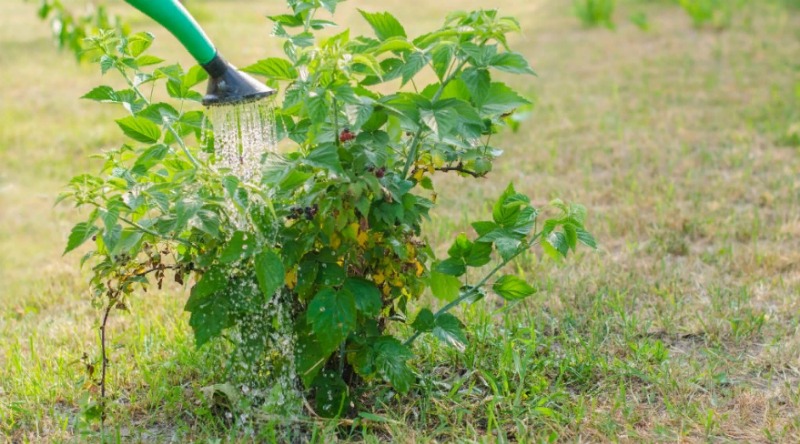
Fundamental rules
To saturate the raspberry bushes with moisture in the required amount, you need to remember a few rules:
- The soil must be dry to a depth of 5 cm.
- Watering the bushes is desirable in the morning or evening.
- You need to pour water at the root, otherwise drops falling on the leaves can cause burns.
- A young plant needs more moisture than an adult.
- Remove all weeds after watering.
- It is mandatory to control the level of soil moisture, since the culture equally does not tolerate drought and excess moisture.
How much to water raspberries in summer
How often you need to water raspberries in the summer depends on the weather and climatic conditions of the region. The watering schedule is based on these factors.
Frequency and abundance of watering
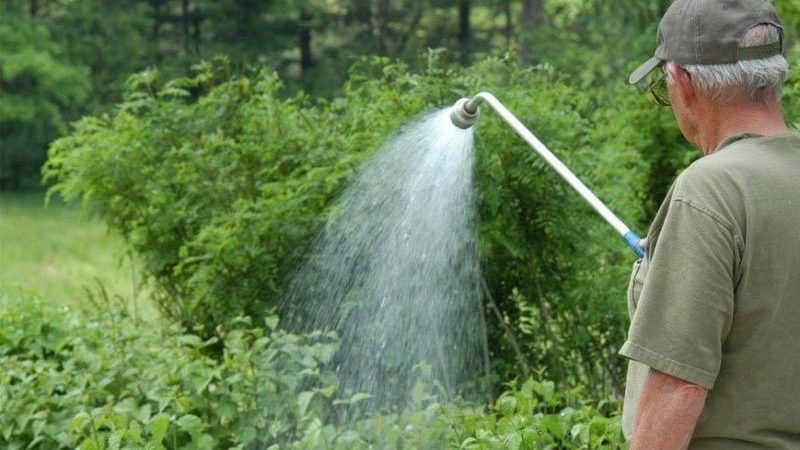
Water the culture at every stage of its growth: during flowering, when the ovaries are formed and during the ripening of fruits.
There are general guidelines for watering raspberries in the summer, but you should also take into account the weather conditions - air temperature and the frequency of rain.
During dry summers, the plant is moistened more often; in the rainy season, there is no benefit in additional liquid.
The plant requires the greatest amount of moisture during flowering and fruiting.
In the middle lane in normal summer, raspberries are watered the first time when the ovaries form, the second time when the berries ripen. For 1 sq. m of raspberry bushes requires 30-35 liters of water.
In the southern regions the crop is watered at least six times during the summer due to the heat and poor rains. The first watering can be done before flowering. When the ovaries begin to form, the bushes are watered again. The third time is when the berries ripen.
After picking the berries, the bush will need moisture 3-4 more times.
The volume of water per 1 sq. M of raspberries should be at least 40 liters.
Reference. After watering, the soil under the bushes is loosened and covered with mulch. Thus, air enters the root system, and moisture in the upper soil layers remains longer.
Irrigation water requirements
Raspberries are sensitive to moisture, but not all water is suitable for her, especially hard ones.
If there is a water supply in the country, tap water is pre-defended so that it becomes softer.
Most of all, the shrub loves rainwater.
The water temperature should not differ much from the air temperature, since the root system of the plant is very sensitive to temperature changes. Too cold water is not suitable for raspberries. To obtain water at the optimum temperature, it is drawn into a tank, where it is heated by the sun's rays.
The ways
Water the plant in several ways. Each of them has a good effect if used correctly.
Basal
This is the simplest method and is used in small areas.In this case, water is delivered directly to the roots of the plant.
Water is poured from a watering can or from a bucket under the root of the plant in a volume of up to 15 liters per 1 bush.
Along furrows
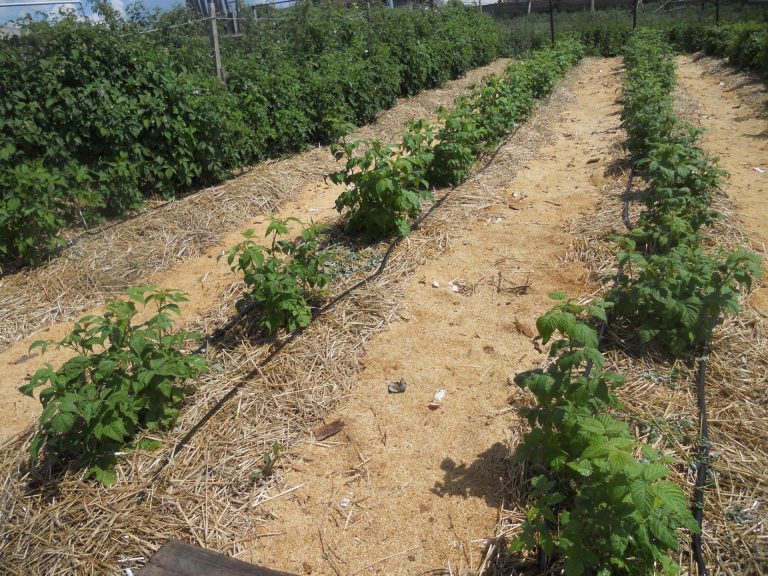
On both sides of the raspberry bushes, grooves up to 15 cm deep are made at a distance of 40-50 cm. Water is allowed through them until the required volume pours out. The water pressure is regulated so that it does not overflow over the edge of the grooves.
After watering, the grooves are filled up, and the soil is loosened.
The advantage of this method is that water does not get onto the plant leaves. The downside is insufficient control of the volume of water, so there is a possibility of waterlogging.
Sprinkling
In this option, water is sprayed as rain over the plants and the soil surface. Use a hose or a special sprinkler.
The installations are convenient in that they can be carried to any place on the site, they consist of lightweight collapsible parts. Special nozzles spray moisture up to 5-8 m. Centrifugal nozzles are also used, which spray water in diameter.
The advantage of sprinkling is economical water consumption, the disadvantage is the likelihood of waterlogging.
Drip
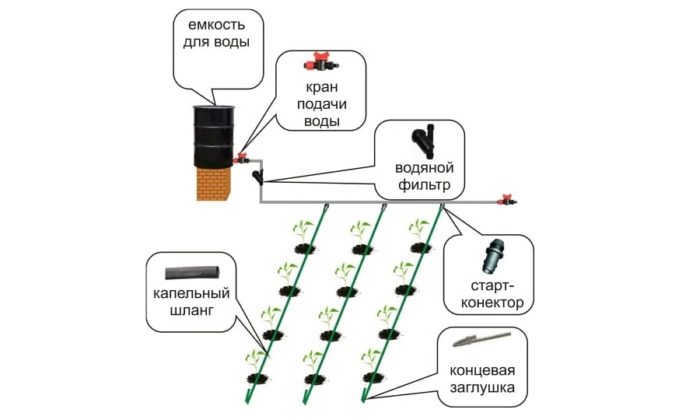
With the help of drip irrigation, water is supplied to the root system of the plant.
The drip system includes several elements:
- container with water;
- pump;
- water filter;
- distribution manifold;
- drip hoses;
- valves to control water flow;
- stubs.
The method is the most convenient and accurate to use. With the help of a pump, water flows from the source to the drip irrigation system and is supplied through hoses to the bushes.
Advantages of the drip system:
- the ability to adjust the water supply;
- dosed water supply to the desired points;
- water is supplied to the roots of the plant, and the aisles remain dry;
- excessive consumption of water and waterlogging of the soil is excluded.
The only drawback of this method is the need for electricity.
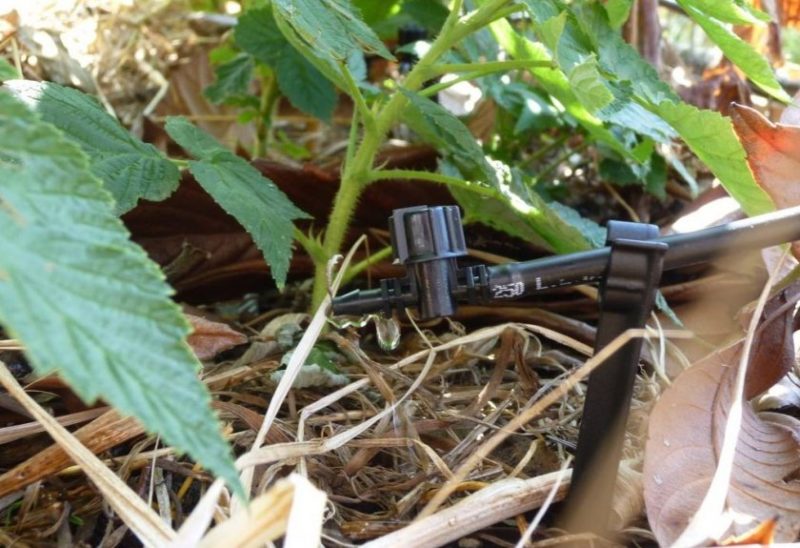
Watering nuances for different stages
Raspberries are watered at different stages of the growing season. Depending on the variety or climatic region, all the features of the procedure are taken into account.
For repairing raspberries
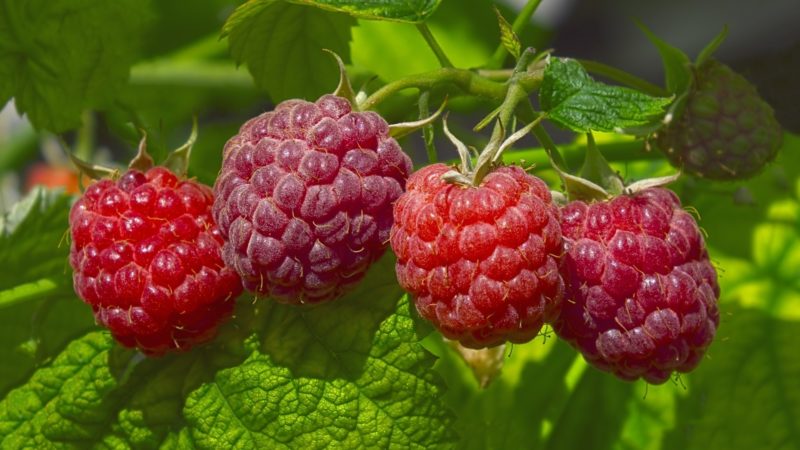
There are a number of features when watering such raspberries. Too moist soil leads to a lack of oxygen, and the roots of remontant raspberries need active air exchange... The optimum soil moisture for these varieties is 60-80% of the lowest moisture capacity.
The greatest need for moisture in a remontant crop is before flowering, during the growth and ripening of berries. Water the plant so that the soil is saturated with moisture to a depth of 30-40 cm.
In dry summers, the frequency of watering is increased. The soil should remain slightly damp.
The most optimal watering method for remontant raspberry - drip.
For different regions
In regions with different climates, crop watering differs mainly in frequency.
Early and mid-season varieties ripen in northern latitudes with short summers. The melt water that forms after snowy winters minimizes spring watering, and in summer, the plant is watered no more than once every two weeks at all stages of the growing season.
In the middle lane, watering begins from late May - early June. It is carried out every two weeks for adult bushes and 2-3 times a week for young cuttings. The plant needs moisture during flowering, ovary formation and berry ripening.
After watering, the soil is loosened and mulched.
In southern latitudes, watering is frequent and abundant throughout the season. In the south, all raspberry varieties ripen, from early to late. The plant needs moisture at all stages of the growing season. In the hottest areas, drip irrigation is used. Bottomless plastic bottles are also widely used. They are buried between the rows and supplied with water from a hose. This ensures constant soil moisture with a dry top layer.
Important! If, as a result of improper watering or prolonged rains, the soil does not dry out, this leads to the formation of root rot and anthracnose. These diseases are not cured.
Tips on the topic
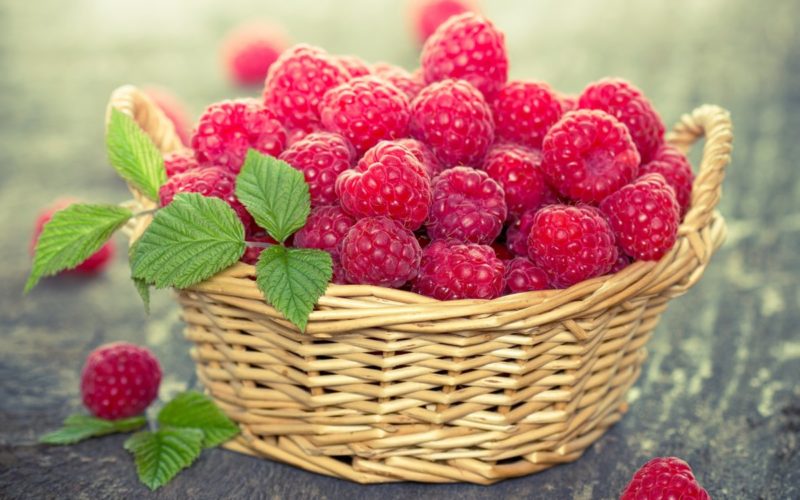
Newbies in horticulture often ask questions: how watering affects the yield, whether it is necessary to water the crop during the ripening of berries, is it possible to combine watering with dressing etc.
Experienced gardeners willingly share their experience:
- Lack of moisture can be easily identified by the appearance of young shoots. If they are short, thin and bend easily, then it's time to water the plant.
- It is advisable to combine watering and fertilization, since feeding apply only to moist soil.
- Sprinkler irrigation is carried out only in the early morning or evening, when there is no direct sun.
- Water flows better to the roots when irrigated in furrows.
- To destroy the larvae of pests, raspberries are treated with boiling water from a distance of 1 m. This procedure is carried out in the spring.
Conclusion
Raspberries need watering throughout the season. The plant needs moisture before and during flowering, at the stage of ovary formation and during the ripening of berries. Taking into account the climatic conditions, the correct choice of irrigation method, the timely and necessary amount of moisture, the plant will delight with an abundant harvest of sweet and juicy berries.